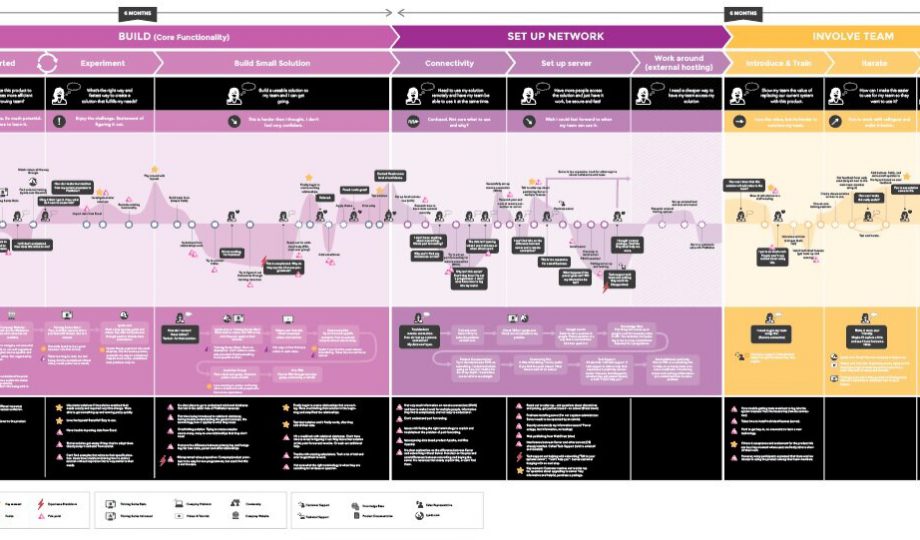
As designers and researchers in service design, human-centered design, or user experience design, we have all experienced challenges in getting our ideas heard at some point. Whether it was a boss or VP who didn’t see the value in our work or a client who only wanted us to make their product look pretty… It’s frustrating, and we get it!
Designers are visionaries and eternal optimists. We see flaws in everything and at the same time see how those experiences could be so much better. We’re plagued by horrible government forms and poorly designed services in our day-to-day lives—always telling our friends “that experience/product/service/website could be so much better… if only they just…” Ultimately, our job in the real world is to create waves, make changes, be innovative, and challenge the status quo. But, what they don’t teach us in design school is how to facilitate transformation and manage change. To be a good designer, you have to communicate well, be a great storyteller, know when to push back, when to concede, and how to balance many perspectives at once.
Now some of us have found ourselves working for companies like Shopify or WealthSimple, who wholly and truly value and understand the importance of human-centered design and research. Unfortunately, the majority of us still aren’t working in those positions.
Unsure to what extent your organization currently adopts UX?
Instead we run into challenges convincing higher-ups to follow the right process and appreciate the difference design and research can make. You’re not alone!
Here are the most common barriers we see:
-
-
Culture of fear
-
No top-level buy-in
-
Not allowed to conduct research
-
Design is seen only as aesthetics
-
Inundated with feature requests
-
As optimists, always believing in a better world, what are we to do when faced with some of these inevitable roadblocks? In this blog post, we’re going to break down the most common roadblocks designers encounter at work and give you our best tips and tricks to overcome them. We’ll provide a crash course on change management and some quick takeaways you can start implementing right away, so you can move the needle and begin to make that change happen. Let’s do it!
Five Common Roadblocks
Let’s break down these roadblocks in more detail. If you find yourself experiencing some of these challenges, don’t stress. We’ve got you covered!
1. Culture of Fear
This is a big one! To create innovative products and services and provide exceptional experiences for your customers, you need to be working for an organization that embraces ambiguity, risk-taking, and experimentation (where it feels safe to fail). Most often, we see the opposite in large corporations and governments. Often executives in positions of power will lead with fear. Maybe they get mad when things are changed without their permission, autonomy to be creative and take action is not given to individuals, and people will get in trouble trying to do something new or different. This culture of fear can lead to employees throwing each other under the bus when something goes wrong and decision-making based on fear. We also see fear manifesting itself in organizations when trying to uncover pain points in the user experience. Here’s what we mean by that: When an issue is discovered through research and documented in a report, these executives fear this means the issue needs to be fixed ASAP and there might will be trouble if it’s not addressed. Therefore, they decide it’s best not to uncover the issue in the first place. We see this exemplified most often in government —they are afraid to do any research because if they find pain points (and, oh boy, we know they will!), all of their efforts will need to shift to solving those problems. Instead, they choose to bury their heads in the sand, pretending the issues aren’t there or acting like they aren’t important (even though this is so far from the truth).
2. No Top-Level Buy-In
Without top-level leaders believing in and championing the benefits of design and research, it can be challenging to make changes. This is yet another side effect of low UX maturity. It usually manifests itself as leaders swooping into meetings with minimal context and being closed off to new ideas because it might slow down implementation. They tend to focus on KPIs (key performance indicators) and deadlines, with no room for big-picture thinking. These executives don’t see the potential in improving the user experience or taking a bit more time to invest in design and research upfront for a longer-term gain.
3. Not Allowed to Conduct Research
Sometimes you aren’t allowed to talk to real customers and users because the company is afraid of upsetting or annoying them. They might be hesitant to show customers a prototype that isn’t finished or is less than perfect to get their feedback. At the same time, they might actually be afraid of finding problems, because then they’ll need to fix them (See Roadblock #1). Other times, they don’t want to conduct any UX or design research because they don’t understand why it’s important. Moreover, they might think they already know who their users are and what they think, feel, and do. And finally, they may say there isn’t enough time and money to conduct research. Whatever the reason, this can be very challenging for designers who want to deliver an exceptional product or service.
4. Design is Seen Only as Aesthetics
Usually, all of these roadblocks indicate an organization with low UX or design maturity. When design is only seen as the look and feel or “final polish” on a product, there is absolutely no opportunity for innovation, solving for hidden needs, or closing poor user experience gaps. This roadblock usually looks like other people (on teams like product, marketing, or engineering) making design decisions and dictating how the product should work and look to a designer. In this instance, the designer often finds themselves overwhelmed and working to create mockup after mockup without actually improving the experience.
5. Inundated with Feature Requests
Whether your organization values design or not, this roadblock can often come up for designers. You might be getting so many requests to design or update features and create mockups and prototypes that you struggle to get it all done. It could be that you’re the only designer in your organization and wish there was another one of you! Or, it could be that there are a few designers on the team, and the whole organization has fallen in love with what you can do, so you are managing requests from many different departments and stakeholders.
Crash Course in Change Management
Ultimately, these roadblocks are in large part due to an organization’s lack of understanding in the power of UX design or HCD (meaning the organization is low on the UX Maturity Scale) and lack of willingness to change. If you’re attempting to move up the UX Maturity Scale or simply trying to implement new and better design processes — you should understand some basic principles about change management.
When it comes to change management, the best practice is to use the ADKAR methodology created by Prosci—ever heard of it? If not, that’s okay! After years of being “design diplomats” and navigating the treacherous waters of bureaucracy and the corporate world, we can break them down for you.
The ADKAR Method (adapted from The Prosci ADKAR Method) involves:
A – Awareness: Understanding and awareness of the need for change within the organization. The number one reason for resistance to change is lack of awareness!
D – Desire: Willingness to change, aid change, or get involved with change. This is a personal choice for individuals and can be difficult to encourage.
K – Knowledge: Knowing how to change, and knowing what to do after the change has been implemented! Both points are necessary for success.
A – Ability: The ability to change – where an individual actually performs the change with training, support, and time.
R – Reinforcement: The new change persists, and is reinforced to last!
Ultimately, in order to make significant changes, people in the organization need to understand that how they approach the design of their products and services today isn’t getting them the results they want (aka better customer satisfaction and retention rates). Then, they need the desire to see that change happen (this can usually be done by presenting an exciting ideal future-state or vision) and leadership needs to be aligned to that vision. After that, a lot of communication, expectation setting, training, and support is needed for a “new way of doing things” to be successful.
Tips to Overcome Roadblocks
We’ve explained that in order to make improvements to those challenges you need to understand some aspects of organizational change management. But, what can you practically take action on right away to start making these changes?
We’ve got a few tips & tricks for you:
1. Host a Lunch & Learn
This can be a surprisingly effective way to start educating executives and team members on the value of UX and HCD. Consider hosting a 90-minute “Lunch and Learn” webinar with a cross-section of company stakeholders. Invite people who are both at the executive level (you’ll need to invite them personally and make sure they understand it’s crucial they attend!) as well as other directors, managers, and team members involved in product and service development. Try to invite people who you feel are open-minded. Make sure to communicate just how valuable research is for avoiding risk during the development process, and don’t waste your time with stakeholders who wouldn’t be excited about improving the experience!
2. Find Champions
This step is also super important. For your organization to start seeing the value in design and research, you need people (other than yourself and your design team) who believe and can do some heavy lifting on your behalf to convince others. Consider these people your “Integrators”. They might be the ones who always back you up in meetings or who showed excitement at the lunch and learn. You’ll want them to be people at different levels of seniority and within various departments. Try to find charismatic people who seem to know many other people in the organization—connectors, if you will.
3. Look for Quick Wins
Sometimes, designers can be a little too altruistic and want to execute flawlessly on an end-to-end design and research project or try out some of the best design tools and methods. But most of the time, VPs/Execs/Directors don’t care about following the design process or about the great deliverable you want to create. They care about results, and they want to see those results quickly. To give them what they want, plan to find smaller projects where you can execute pieces of the HCD process successfully. This will show them how impactful even a tiny amount of research could be. You could also take it upon yourself to create new wireframes of a future state or host a workshop! In the beginning, before you get the go-ahead for a major research initiative or design overhaul, you need to find ways to get some quick wins that will highlight the value of human-centered design.
4. Show Proof
Once you’ve had some quick wins (a few smaller projects that went well and were helpful), make sure to document them as case studies. Doing this will be necessary for reminding people of what HCD, when done correctly, can do —and it will be an incredible physical piece of evidence easily shared across the organization. Make it a compelling and beautiful document that’s quick and easy to read —then share with whoever you can!
5. Build a Business Case
Alright, so you’ve had some quick wins and built a few solid case studies. Now you need to build a business case for the executive team on the value of design. Why? So that you can start to get more time, budget, and resources allocated to following the proper design and research methodologies. You’ll want to present a value proposition for why this work is so important and how it will help the company achieve its goals. Then, present them with a compelling alternative future: If they took a human-centered approach and moved from a product-centered model to a customer-centered one, what would that do for them? In addition, wherever possible, try to tie dollars/revenue to the value proposition. What is the ROI? How much money could they save if the product was easy-to-use (and they weren’t spending so much on customer support calls, for example)?
6. Host a Business Origami Session
This is a wonderful method in service design where you have stakeholders in a workshop physically map out all of the steps involved in a particular scenario. They’ll use stick figures or pictures to represent all the people/users involved, draw out buildings, and have game pieces representing different touchpoints like forms, websites, and more. Then, the stakeholders act out what it’s like for users to go through their service and all of the actions they have to take to accomplish their goal. The beauty of this method is that it’s easy to set up and powerful for stakeholders (who are usually far removed from actual customers and users) to see how complicated and painful a service can be. It’s as if they are experiencing the frustration for themselves —and that can help them see why a more human-centered approach could make that service experience endlessly better and more efficient.
7. Hire an External Consultancy – Like Us!
Sometimes you need boots on the ground with a lot of experience who can also bring a fresh perspective. An external consultancy can help you articulate the value of HCD and work with you to create new processes and methods that will set the foundation moving forward.
If you’re an eternally optimistic designer ready to finally receive buy-in from your organization, we hope you find value in our advice. We’ve been there and know how hard it can be, but don’t give up! The reward of overcoming these challenges is BEYOND worth the struggle.



